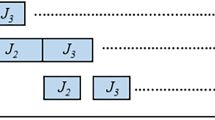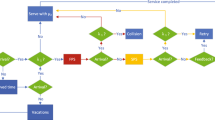Abstract
We revisit the well-known problem of scheduling in \(N\ge 2\) non-observable parallel single-server queues with one dispatcher having no queue to store the incoming jobs. The dispatcher does not observe the current states of the queues and servers and the sizes of the incoming jobs. The only available information to it is the job size distribution, job’s inter-arrival time distribution and server’s speeds. For this problem setting it is known that if the dispatcher can memorize the sequence of its previous decisions, then a deterministic policy is better than the random choice policy with respect to the job’s mean waiting and mean sojourn time. In this paper we address the following question: can the deterministic policy be improved if the dispatcher, in addition to the decisions made, can memorize also the times between the decisions? We describe the new policy and numerically show that it is almost always possible to do better with it than with the deterministic policy. Two algorithms for choosing decisions under the new policy are given. Both are based on the Lindley recursion and are approximate in nature, because utilize the discretization of the underlying distributions. Our findings show that the relative gain of the new policy may reach \(10\%\), when minimizing job’s mean sojourn time, and more than \(50\%\) for the job’s mean waiting time.








Similar content being viewed by others
Notes
It means that the dispatcher does not have a queue to store the jobs.
Even so, discrete probability distributions are also allowed. The numerical procedures will require some refinements in order to align the discrete grids.
Because of the constraints, which are put by the assumptions on the admissible policies, sometimes in the literature the latter are called “blind” scheduling policies.
Discretization is also justified by the fact that in practice, there exists a minimal time gap, when nothing happens in the system: minimal inter-arrival time or minimal service time. This minimal value can be taken as the discretization step size. As it will be seen from the experimental results, we may even a larger value for the step size without any harm for the results.
The following observation is worth noticing here. For the two single-server fully observable queues, operating in parallel, it is known that the optimal policy, with respect to the mean sojourn time, is of threshold type (see a short review in [26] and references therein). For the general case, when the number of queues is greater than two, the structure of the optimal policy is not known. Here the constant \(\theta \) can be considered, to some extent, as a threshold, which introduction leads to the policy improvement.
The value of \(\varDelta \) must be less than than both the expected inter-arrival time and the expected time between service completions across all the servers.
For example, for the two-server system the optimal deterministic policy always exists. In the case \(N\rightarrow \infty \), it is more reasonable to develop approximations instead of using exact formulae (see [5]).
Some DET policies may be periodic, others may not. For example, for the two single-server queues in parallel with exponential service at rates 1 and 2 respectively and Poisson flow at rate 1, the optimal DET policy with respect to the mean sojourn time is the periodic policy \((11011011101101101110)^\infty \). Here 0 means that the job is routed to the server with rate 1. We can imagine a corresponding RND policy not with one parameter \(p_0\) (\(p_1=1-p_0\)), but with \(2^{19}\) parameters. It remains an open question whether such an RND policy can do as good as DET or, in general, whether it can be better than DET, when the latter is not optimal.
References
Abate J, Ward W (1994) Transient behavior of the M/G/1 workload process. Oper Res 42(4):750–764
Ackroyd MH (1986) Approximate characterisation of nonstationary discrete time G/G/1 systems. Perform Eval 6(2):117–123
Altman E, Gaujal B, Hordijk A (2000) Balanced sequences and optimal routing. J ACM 47(4):752–775
Anselmi J, Gaujal B (2010) The price of anarchy in parallel queues revisited. SIGMETRICS Perform Eval Rev 38(1):353–354
Anselmi J, Gaujal B (2011) The price of forgetting in parallel and non-observable queues. Perform Eval 68(12):1291–1311
Anselmi J, Gaujal B, Nesti T (2015) Control of parallel non-observable queues: asymptotic equivalence and optimality of periodic policies. Stoch Syst 5(1):120–145
Aven T (1985) Upper (lower) bounds on the mean of the maximum (minimum) of a number of random variables. J Appl Prob 22(3):723–728
Barbierato E, Gribaudo M, Iacono M (2011) Exploiting multiformalism models for testing and performance evaluation in SIMTHESys. In: Proceedings of 5th international ICST conference on performance evaluation methodologies and tools—VALUETOOLS 2011, pp 121–130
Becker K, Gaver D, Glazebrook K, Jacobs P, Lawphongpanich S (2000) Allocation of tasks to specialized processors: a planning approach. Eur J Oper Res 126(1):80–88
Brun O (2016) Performance of non-cooperative routing over parallel non-observable queues. Probab Eng Inf Sci 30:455–469
Cao X (2007) Stochastic learning and optimization–a sensitivity-based approach. Springer, Berlin
Cesario E, Mastroianni C, Talia D (2012) Using mining@home for distributed ensemble learning. In: Proceedings of 5th international conference data management in cloud, grid and P2P systems, Globe 2012, Vienna, Austria, September 5–6, pp 100–111
Combé MB, Boxma OJ (1994) Optimization of static traffic allocation policies. Theor Comput Sci 125(1):17–43
Ephremides A, Varaiya P, Walrand J (1980) A simple dynamic routing problem. IEEE Trans Autom Control 25(4):690–693
Gallot S (1966) A bound for the maximum of a number of random variables. J Appl Probab 2(3):556–558
Gaujal B, Hyon E, Jean-Marie A (2006) Optimal routing in two parallel queues with exponential service times. Discrete Event Dyn Syst 16(1):71–107
Guo X, Lu Y, Squillante MS (2004) Optimal probabilistic routing in distributed parallel queues. SIGMETRICS Perform Eval Rev 32(2):53–54
Gupta V, Harchol Balter M, Sigman K, Whitt W (2007) Analysis of join-the-shortest-queue routing for web server farms. Perform Eval 64(9–12):1062–1081
Hajek B (1983) The proof of a folk theorem on queuing delay with applications to routing in networks. J ACM 30(4):834–851
Harchol-Balter M, Scheller-Wolf A, Young AR (2009) Surprising results on task assignment in server farms with high-variability workloads. SIGMETRICS Perform Eval Rev 37(1):287–298
Heidergott B, Olsder GJ, van der Woude J (2006) Max plus at work: modeling and analysis of synchronized systems: a course on max-plus algebra and its applications. Princeton University Press, Princeton
Hordijk A, van der Laan D (2004) Periodic routing to parallel queues and billiard sequences. Math Methods Oper Res 59(2):173–192
Hordijk A, Koole GM, Loeve JA (1994) Analysis of a customer assignment model with no state information. Probab Eng Inf Sci 8:419–429
Hordijk A, Loeve A, Tiggelman J (1998) Analysis of a finite-source customer assignment model with no state information. Math Methods Oper Res 47(2):317–336
Humblet P (1982) Determinism minimizes waiting time in queues. The laboratory for information and decision systems technical report ser LIDS-P/1207. https://dspace.mit.edu/handle/1721.1/2806. Accessed 1 Mar 2018
Hyytia E (2013) Optimal routing of fixed size jobs to two parallel servers. INFOR Inf Syst Oper Res 51(4):215–224
Jakobik A, Grzonka D, Palmieri F (2017) Non-deterministic security driven meta scheduler for distributed cloud organizations. Simul Modell Pract Theory 76:67–81
Javadi B, Kondo D, Vincent JM, Anderson DP (2011) Discovering statistical models of availability in large distributed systems: an empirical study of seti@home. IEEE Trans Parallel Distrib Syst 22(11):1896–1903
Javadi B, Thulasiraman P, Buyya R (2012) Cloud resource provisioning to extend the capacity of local resources in the presence of failures. In: 2012 IEEE 14th international conference on high performance computing and communication 2012 IEEE 9th international conference on embedded software and systems, pp 311–319
Konovalov M, Razumchik R (2016) Dispatching to two parallel nonobservable queues using only static information. Informatika i ee Primeneniya 10(4):57–67
Konovalov M, Razumchik R (2017) Using inter-arrival times for scheduling in non-observable queues. In: Proceedings of 31th European conference on modelling and simulation, ECMS 2017, Budapest, Hungary, 2017, pp 667–672
Konovalov MG (2007) Methods of acaptive information processing and their applications. Institute of Informatics Problems of RAS, Kaliningrad
Kraemer W, Langenbach-Belz M (1976) Approximate formulae for the delay in the queueing system GI/G/1. In: Proceedings of 8th international teletraffic congress, pp 2351–2358
Sharifnia A (1997) Instability of the join-the-shortest-queue and fcfs policies in queueing systems and their stabilization. Oper Res 45(2):309–314
Sragovich V (2005) Mathematical theory of adaptive control. World Scientific, Singapore
Stadje W (1997) A new approach to the Lindley recursion. Stat Probab Lett 31(3):169–175
Vuyst SD, Bruneel H, Fiems D (2014) Computationally efficient evaluation of appointment schedules in health care. Eur J Oper Res 237(3):1142–1154
Acknowledgements
This work was supported by the Russian Foundation for Basic Research (Grant 18-07-00692).
Author information
Authors and Affiliations
Corresponding author
Rights and permissions
About this article
Cite this article
Konovalov, M., Razumchik, R. Improving routing decisions in parallel non-observable queues. Computing 100, 1059–1079 (2018). https://doi.org/10.1007/s00607-018-0598-5
Received:
Accepted:
Published:
Issue Date:
DOI: https://doi.org/10.1007/s00607-018-0598-5




